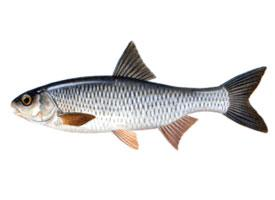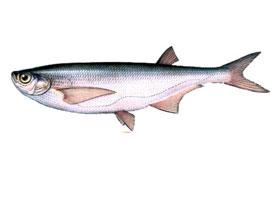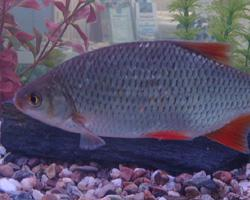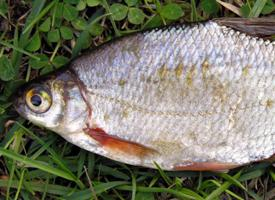
Greutăți și măsuri
| Lungime | 40 cm |
|---|---|
| Greutate | 1 kg |
Date biologice
| Durata de viață | 13 r |
|---|
Descrierea animalului
The Common dace, scientifically named Leuciscus leuciscus, is a freshwater and brackish fish that belongs to the Cyprinidae family, which is widely distributed across Europe and parts of Asia. This species is renowned for its adaptability to various aquatic environments, ranging from slow-moving rivers and streams to lakes and ponds, including brackish waters near coastal areas. The Common dace is a vital component of freshwater ecosystems, serving as both a predator of smaller organisms and prey for larger aquatic and terrestrial predators.Physically, the Common dace exhibits a slender, elongated body shape that is typical of many cyprinids, facilitating swift, agile movements in the water. Adults can reach a length of up to 40 centimeters (cm), but the average size is usually around 15 to 25 cm. The body is covered in shiny, silvery scales that provide an effective camouflage against predators when the fish is in motion. The dorsal side of the fish is darker, ranging from dark gray to greenish-brown, which gradually fades into a silver-white belly. This coloration allows the Common dace to blend seamlessly with the riverbed and avoid detection.
One of the distinguishing features of the Common dace is its lateral line system, which is highly sensitive and helps the fish detect vibrations and pressure changes in the water, enabling it to navigate, forage, and evade predators efficiently. The fish has a single dorsal fin, positioned towards the middle of its back, and a forked caudal (tail) fin that provides propulsion. The anal and pelvic fins are located on the underside, contributing to stability and maneuverability.
The diet of the Common dace primarily consists of invertebrates, such as insect larvae, small crustaceans, and worms, although they are known to occasionally consume plant matter and small fish. Their feeding habits make them an important link in the aquatic food chain, transferring energy from lower to higher trophic levels.
Reproduction in the Common dace typically occurs in spring when water temperatures rise. They are known for their spawning behavior, where females release thousands of eggs into shallow, gravelly, or sandy areas of rivers and streams. The males then fertilize the eggs externally. This species does not exhibit parental care; the eggs and resulting fry are left to fend for themselves, facing high predation rates.
The Common dace is considered to be of least concern by conservation organizations, indicating that it is currently not at risk of extinction. However, like many freshwater species, it faces threats from habitat degradation, pollution, and the introduction of invasive species, which can impact populations. Efforts to maintain clean, healthy waterways and natural habitats are crucial for the preservation of the Common dace and the broader biodiversity of freshwater ecosystems.
In summary, the Common dace (Leuciscus leuciscus) is a fascinating and ecologically important fish species with a wide distribution in European and Asian freshwater systems. Its physical adaptations, feeding habits, and reproductive strategies make it a resilient and integral part of aquatic communities, contributing to the health and balance of freshwater ecosystems.
Animale similare
Fotografii noi cu animale
Top 10 animale
- Dolphin gull (Leucophaeus scoresbii)
- Diana monkey (Cercopithecus diana)
- Moustached guenon (Cercopithecus cephus)
- Greek tortoise (Testudo graeca)
- Stone loach (Barbatula barbatula)
- Galápagos tortoise (Geochelone nigra complex)
- Japanese macaque (Macaca fuscata)
- Russian tortoise (Testudo horsfieldii)
- Common flying dragon (Draco volans)
- Galápagos penguin (Spheniscus mendiculus)


